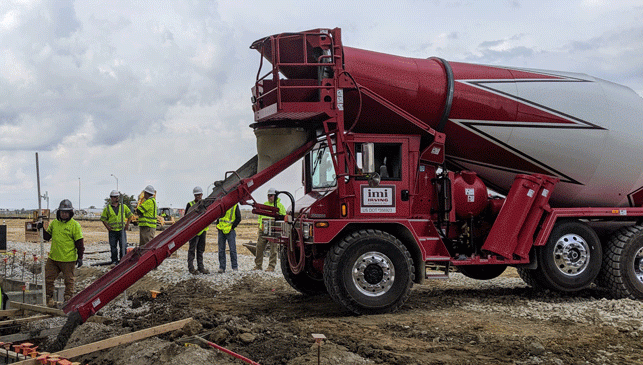The role of sustainable concrete in digital infrastructure growth
Dallas-based Compass Datacenters LLC announced in May 2020 its intention to require the CarbonCure Technologies process for ready mixed concrete supplied to all of the company’s future property developments. Is the move indicative of a trend in information technology facility construction toward lower net carbon?

|
| PHOTOS: MDH Partners |

|
| A 226,000 sq.-ft. warehouse of tilt-up construction, the Cedar Creek Distribution Center (above) booked a 140,000-lb. carbon dioxide savings owing to the use of CarbonCure Technologies process for an 8,250-yd. concrete schedule. Project principals: MDH Partners, owner; FCL Constructors, general contractor; Ware Malcomb, architect; Haines Gibson, structural engineer; Southeast Concrete Systems, concrete subcontractor; Irving Materials Inc., ready mixed supplier. RENDERING: MDH Partners and Ware Malcomb |

|
With the Covid-19 pandemic and its resulting global economic downturn, the construction landscape is shifting. In particular, activity for businesses dependent on tourism such as hospitality, food service, and retail has stalled. Despite this unprecedented era, growth opportunities for construction in other industries are emerging. Digital infrastructure and e-commerce businesses are especially poised for growth within the next five years. This is expected to have a significant impact on construction as these industries need sound, physical space to support and deliver their services.
CNBC Retail asserted in a July 2020 report that the “U.S. may need another 1 billion square feet of warehouse space by 2025 as e-commerce booms.” As traditional retail real estate suffers from store closures and plummeting rents, the need for fulfillment centers to service online shopping grows. Similarly, as online activity continues to expand, digital infrastructure such as data centers is required to support the growth of online activities. Digital and e-commerce infrastructure—whether it be a data center to house IT storage or a fulfillment center to house goods sold online—have one thing in common: they require a lot of concrete.
A single fulfillment, distribution, or data center may require 100,000 yd. or more. Concrete specifications tend to be quite robust, as these centers often require high-quality finishing and durability performance to ensure slabs can withstand conditions such as the daily impact of specialized machinery transporting packages across an exposed floor. The insulation function of concrete enclosures is also crucial for keeping expensive server rooms cool and dry.
Perhaps a less obvious characteristic many of these new digital infrastructure projects require is the appetite for sustainable innovation. The e-commerce industry is constantly striving to reduce the carbon footprint of its operations to meet consumer demands for sustainability.
Digital infrastructure, on the other hand, is built directly by Silicon Valley technology companies or developers who service them. Many of the world’s leading technology providers have positioned themselves at the forefront of the decarbonization movement, and include sustainable construction practices in their public-facing sustainability roadmaps. For example:
- Microsoft recently announced plans to be carbon negative by 2030 and that it “will remove from the environment more carbon than the company has emitted since its founding by 2050.”
- Amazon, a prolific builder of office space and fulfillment centers, launched its Climate Pledge in 2019, committing to reach net-zero carbon by 2040.
- Walmart is expanding into e-commerce through its recently announced partnership with Shopify. Both entities have made ambitious climate commitments.
- Apple committed last month to being 100 percent carbon neutral in its supply chain operations by 2030.
Sharing in this commitment to carbon reduction, Compass Datacenters is adopting the CarbonCure process, whereby concrete producers add carbon dioxide during mixing. Mineralization of the CO2 gas augments cementitious materials efficiency, creating more sustainable, low-carbon concrete.
“Our data centers use concrete in many areas, from foundations and sidewalks to precast walls and roofing,” says Compass Chief Innovation Officer Nancy Novak. “We estimate using CarbonCure will reduce our CO2 footprint by an average of 1,800 tons per campus. That’s equivalent to CO2 sequestered by 2,100 acres of forest or [emitted by] driving a car 4 million miles. Our research and development investments are unique to the data center provider space but continually pay off with a lower-cost, faster-to-build, high-quality product.”
The commitment to sustainability is apparent not only in the development of large-scale IT infrastructure facilities, but also in smaller distribution centers that exist in nearly every corner of the country. One example is the Cedar Creek Distribution Center, a 226,000-sq.-ft. warehouse facility just outside of Nashville in Lebanon, Tenn. The tilt-up project includes an estimated 8,250 yd. of CarbonCure concrete supplied by Irving Materials, Inc. The mix specification is expected to save about 140,000 pounds of CO2, equivalent to the volume that 82 acres of trees would absorb in a year.
Notes Arun Singh, chief financial officer at MDH Partners, Cedar Creek Distribution Center owner, “MDH develops and manages traditional industrial real estate properties with an entrepreneurial mindset. We believe that social responsibility as it relates to our communities and environment is a core principle of good business. We’re proud to have reduced the carbon footprint of Cedar Creek Distribution Center, and intend to continue to use CarbonCure in future construction across the country.”
These examples demonstrate that, although the current economic climate is turbulent, there are always opportunities for growth. Digital and e-commerce infrastructure represents an opportunity for concrete producers to stay the course with plant volume despite wider economic uncertainty. Concrete producers who embrace sustainable innovation now will be best positioned to compete for these new opportunities. In an era of economic turbulence, companies with the agility to adapt to the conditions will inevitably rise to the top.
Christie Gamble is Senior Director of Sustainability for CarbonCure Technologies in Dartmouth, Nova Scotia; she can be contacted at [email protected].